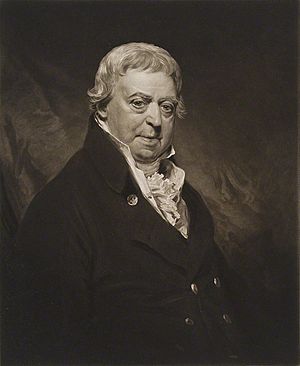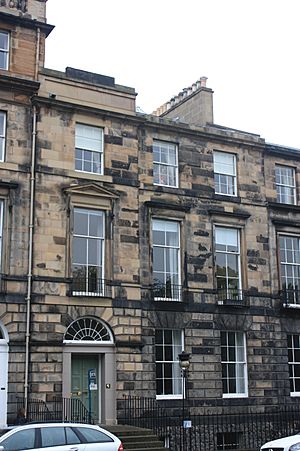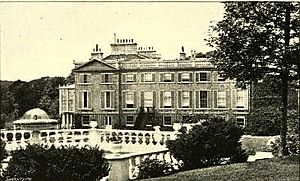James Ferguson (Scottish politician) facts for kids
Quick facts for kids
James Ferguson
3rd Laird of Pitfour
|
|
|---|---|

A portrait of Ferguson from 1818
|
|
| Member of Parliament for Aberdeenshire |
|
| In office 1790–1820 |
|
| Preceded by | George Skene |
| Succeeded by | William Gordon |
| Member of Parliament for Banffshire |
|
| In office 1789–1790 |
|
| Preceded by | Sir James Duff |
| Succeeded by | Sir James Grant, Bt |
| Personal details | |
| Born | 25 May 1735 Pitfour, Aberdeenshire, Scotland, |
| Died | 6 September 1820 (aged 85) |
| Occupation | Advocate and politician |
James Ferguson (born May 25, 1735 – died September 6, 1820) was a Scottish lawyer and politician. He was the third Laird of Pitfour. This was a very large estate in the north-east of Scotland. It was sometimes called the 'Blenheim of the North' because it was so grand.
Ferguson studied law in Edinburgh. He became a qualified lawyer in 1757. After his studies, he traveled around Europe in 1758. He then followed his father's path and joined the Scottish legal profession. Later in his life, he became interested in politics. He joined the Tory party in Scotland.
James Ferguson did a lot of work to improve the Pitfour estate. He started building a canal to connect the estate to the sea at Peterhead. This canal was meant to transport farm goods. Work on the canal began in 1797, even though some neighbors disagreed. He also helped create the planned village of Mintlaw in 1813.
Contents
Early Life and Family History
James Ferguson was born at Pitfour on May 25, 1735. He was the oldest son of James Ferguson (1700–1777) and Ann Murray (1708–1793). His parents got married in 1733. James was born three years later. He had five younger brothers and sisters.
Before traveling around Europe in 1758, Ferguson studied law in Edinburgh. This was a family tradition. He became a member of the Faculty of Advocates in July 1757. This meant he could work as a lawyer.
Ferguson spent a lot of time at Pitfour. He also had a home in London. He became the third Laird of Pitfour when his father died in 1777.
He was friends with important people like James Boswell. He also knew William Pitt the Younger, who was a Prime Minister. His brother, Patrick Ferguson, was famous for inventing the Ferguson rifle.
From 1794 to 1796, James Ferguson was the Rector of Aberdeen University. This was an important role at the university.
A report from 1788 described Ferguson as "a man of real good sense, but indolent." This means he was smart but sometimes not very active. He was described as plain, small, and stocky in appearance.
James Ferguson never married. Around 1813, he helped create the village of Mintlaw. He also helped expand the village of Longside in 1801.
Before he died, his home in Edinburgh was at 30 Heriot Row. This was in the Second New Town area.
He passed away in September 1820 in London. He did not have any children. So, the Pitfour estate went to his younger brother, George Ferguson. George was 72 years old and not in good health.
Political Career
Ferguson became a Scottish Tory politician. He was a member of the House of Commons of Great Britain from 1788 to 1800. Then he was in the House of Commons of the United Kingdom until he died in 1820.
In 1786, he tried to become the Member of Parliament (MP) for Aberdeenshire. He had the support of the Duke of Gordon. But he lost the election to George Skene. Skene was supported by the Earl of Fife, who had a lot of power. Only 190 people could vote in Aberdeenshire at that time. Ferguson lost by just ten votes.
Ferguson was elected as the MP for Banffshire in 1789. He held this seat until 1790. In the 1790 general election, he was elected as the MP for Aberdeenshire. He kept this seat for 30 years until his death.
He became a close friend and political ally of Prime Minister William Pitt the Younger. After Pitt died in 1806, it was harder for Ferguson to keep his seat. In the 1806 election, he won by only two votes. His opponent, General Alexander Hay, accused him of bribery. Ferguson beat Hay again in 1807, this time with a bigger lead. After that, Ferguson ran unopposed in the next three elections.
Some records say Ferguson rarely spoke in Parliament. He is recorded as speaking at least five times over the years.
Changes to Scottish politics happened after 1832. The Scottish Reform Act 1832 gave more people the right to vote. Before this, only landowners and a few merchants controlled politics. The number of voters grew from under 5,000 to 65,000.
Pitfour Estate Development
The Pitfour Estate was near Mintlaw in north-east Scotland. It became one of the largest and most impressive estates in the country. This was during the 18th and 19th centuries. Old maps show the estate as Petfouir or Petfour.
Ferguson's grandfather bought the estate in 1700. Both his grandfather and father worked to develop it. Pitfour covered about 50 square miles. It was worth a lot of money in the 18th century. James Ferguson, the third Laird, did much of the work on the main house. The architect John Smith designed the house in 1809. One writer called the estate the "Blenheim of Buchan."
Pitfour's Canal and Lake
James Ferguson was Laird of Pitfour during the Industrial Revolution. This was a time of great change in Britain. He started building a canal between Pitfour and Peterhead in 1797. Many nearby landowners were against this project. The canal was planned to be about ten miles long. It would follow the River Ugie. It was also called the St Fergus and River Ugie Canal.
Ferguson had thought about this canal since 1793. But it was never finished. This was because of problems with getting agreements from neighbors. The Merchant Maiden Hospital, which owned land nearby, had strong objections. They tried to stop the work. In July 1797, they succeeded in getting a court order to stop the building. By then, two miles of the canal had been dug.
A few years after starting the canal, Ferguson built a large artificial lake. It was in front of the main house. The lake is almost 50 acres in size. It was inspired by the artificial lake at Windsor Great Park. A landscape designer named William Sawrey Gilpin may have helped with the work.
Later History of the Estate
When James Ferguson died in 1820, his younger brother, George Ferguson, inherited the estate. George died soon after. His son, also named George Ferguson, then took over.
This younger George added more to the estate. He built a stable block, a race course, and an observation tower. However, he had big gambling debts. Even though the estate was very valuable, he had to sell off many parts of it. When he died, the estate had huge debts. His son, George Arthur Ferguson, continued to sell off parts of the estate. The mansion house was eventually torn down in 1926.
Images for kids








